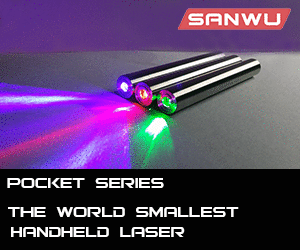I thought this could be an interesting (and colorful) thread to keep updated. The idea is to track current
diode laser wavelengths.
My proposed guidelines:
- Only visible wavelengths from 390 to 750, and only pure diodes, not DPSS.
- Cite sources unless it's a common wavelength
- Package type (9mm, 5.6mm, C-Mount, etc) isn't important, but something clearly outside the realm of portability doesn't count.
- If wavelength is given as a range, take the midpoint, and if that gives a .5, round up.
- Differentiate between
(C) common OR cheap, (E) exists but impractical or costly, and (R) rumoured or anounced.
- If a particular wavelength has more than one entry, in different (C,E,R) letter categories, the most favorable letter will be indicated (C>E>R)
I'll give this a start:
405 nm - (C) - Multiple manufacturers, Sanyo, Mitsubishi, etc
415 nm - (E) - Roithner RLT415-200PMG
445 nm - (C) - Nichia (they specify wavelength as "440 to 455", but these diodes are most commonly referred to as 445)
450 nm - (E) - Soraa Announcement, and Osram Available
473 nm - (E) - Nichia NDHA210APAE1 (likely same as Thorlabs L473P020MLD)
488 nm - (E) - Nichia NDB7352 (likely same as Thorlabs L488P060MLD
510 nm - (E) - Nichia Announcement
523 nm - (R) - Soraa Announcement
531 nm - (R) - Sumitomo Announcement (2009)
622 nm - (E) - LDX Optronics LDX-2106-622
635 nm - (C) - Multiple manufacturers (through to 642nm), Hitachi, Sanyo, Opnext, etc
657 nm - (C) - Multiple manufacturers
670 nm - (C) - Multiple manufacturers
685 nm - (C) - Eudyna FLD6A2TK
It will sure be nice to see some of those Rs become Es, and Es become Cs

Lets keep this updated as news pops up!



